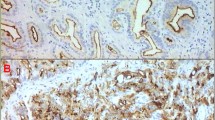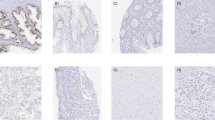Abstract
Diagnosis of prostatic adenocarcinoma is usually not difficult in biopsy specimens. Problems may occur in biopsy specimens, containing only a few suspicious lesions. Recently, P504S has been tested as a new marker for prostatic carcinoma. When over-expressed in atypical glands without basal cells, it establishes the diagnosis of prostatic carcinoma. We analysed the staining intensity of P504S in 208 biopsy specimens from prostates (1) with adenocarcinoma (n=132), (2) with high-grade prostatic intraepithelial neoplasia (HGPIN) with adenocarcinoma (n=36), (3) with HGPIN alone (n=40) and in radical prostatectomy specimens with HGPIN adjacent to (n=54) or distant from adenocarcinoma (n=64). P504S expression was negative to weakly positive in biopsy specimens showing HGPIN without carcinoma and weakly positive in radical prostatectomy specimens revealing HGPIN distant from adenocarcinoma. In biopsy specimens with a combination of HGPIN and adenocarcinoma and in radical prostatectomy specimens with HGPIN adjacent to adenocarcinoma, P504S was strongly expressed. The same findings were made in radical prostatectomy specimens containing adenocarcinoma and HGPIN adjacent to or distant from adenocarcinoma and in preoperative biopsies revealing adenocarcinoma and HGPIN. These results suggest that moderate to strong P504S expression in HGPIN of biopsy specimens is indicative of an associated adenocarcinoma and may be helpful in the choice of therapy.






Similar content being viewed by others
References
Beach R, Gown AM, de Peralta-Venturina MN, Folpe AL, Yaziji H, Salles PG, Grignon DJ, Fanger GR, Amin MB (2002) P504S immunohistochemical detection in 405 prostatic specimens including 376 18-gauge needle biopsies. Am J Surg Pathol 26:1588–1596
Bishara T, Ramnani DM, Epstein JI (2004) High-grade prostatic intraepithelial neoplasia on needle biopsy. Risk of cancer on repeat biopsy related to number of involved cores and morphologic pattern. Am J Surg Pathol 28:629–633
Bostwick DG (1995) High grade prostatic intraepithelial neoplasia. The most likely precursor of prostate cancer. Cancer 75:1823–1836
Gologan A, Bastacky S, McHale T, Yu J, Cai C, Monzon-Bordonaba F, Dhir R (2005) Age-associated changes in alpha-methyl CoA racemase (AMACR) expression in nonneoplastic prostatic tissues. Am J Surg Pathol 29:1435–1441
Helpap B (1998) Differential diagnosis of glandular proliferations in the prostate. A conventional and immunohistochemical approach.Virchows Arch 433:397–405
Helpap B (2004) Prostatic adenocarcinoma—still a diagnostic problem. Verh Dtsch Ges Pathol 88:152–157
Helpap B (2005) Radical prostatectomy without preoperative diagnosis of invasive carcinoma. Is it justified? A case report. In: Egevad L, Algaba F (eds) The most challenging cases of the year in uropathology. 20th European congress of pathology, Paris (in press)
Helpap B, Köllermann J (1999) Atypical acinar proliferations of the prostate. Pathol Res Pract 195:795–799
Helpap B, Köllermann J, Oehler U (2001) Limiting the diagnosis of atypical small glandular proliferations in needle biopsies of the prostate by the use of immunohistochemistry. J Pathol 193:350–353
Helpap B, Sinicina I (2002) Diagnostische Maßnahmen zur Therapieplanung des Prostatakarzinoms. Informationsaustausch zwischen Patienten-Urologen-Pathologen. Urologe B 42:121–127
Jiang Z, Woda BA, Rock KL, Xu Y, Savas L, Khan A, Pihan G, Cai F, Babcook JS, Rathanaswami P, Reed SG, Xu J, Fanger GR (2001) P504S: a new molecular marker for the detection of prostate carcinoma. Am J Surg Pathol 25:1397–1404
Jiang Z, Wu C-L, Woda BA, Dresser K, Xu J, Fanger GR, Yang XJ (2002) P504S/alpha-methylacyl-CoA racemase. A useful marker for diagnosis of small foci of prostatic carcinoma on needle biopsy. Am J Surg Pathol 26:1169–1174
Jiang Z, Fanger GR, Woda BA, Banner BF, Algate P, Dresser K, Xu J, Chu FG (2003) Expression of alpha-methylacyl-CoA racemase (P504S) in various malignant neoplasms and normal tissues: a study of 761 cases. Hum Pathol 34:792–796
Jiang Z, Wu CL,Woda BA, Iczkowski KA, Chu PG, Tretiakova MS, Young RH, Weiss LM, Blute RD, Brendler CB, Krausz T, Xu JC, Rock KL, Amin MB, Yang XJ (2004) Alpha-methylacyl-CoA racemase: a multi-institutional study of a new prostate cancer marker. Histopathology 45:218–225
Lou J, Zha S, Gage WR (2002) Alpha-methylacyl-CoA racemase: a new molecular marker for prostate cancer. Cancer Res 62:2220–2226
Magi-Galluzzi C, Luo J, Isaacs WB, Hicks JL, De Marzo AM, Epstein JI (2003) Alpha-methylacyl-CoA racemase. A variably sensitive immunohistochemical marker for the diagnosis of small prostate cancer foci on needle biopsy. Am J Surg Pathol 27:1128–1133
Molinie V, Herve JM, Lugagne PM, Baglin AC (2004) P63 and P504S cocktail is useful in ambiguous lesions of the prostate. Histopathology 44:403–404
Rubin MA, Zhou M, Dhanasekaran SM (2002) Alpha-methylacyl coenzyme. A racemase as a tissue biomarker for prostate cancer. JAMA 287:1662–1670
Varma M, Jasani B (2005) Diagnostic utility of immunohistochemistry in morphologically difficult prostate cancer: review of current literature. Histopathology 47:1–16
Wu C-L, Yang XJ, Tretiakova M, Patton KT, Halpern EF, Woda BA, Young RH, Jiang Z (2004) Analysis of alpha-methylacyl-CoA racemase (P504S) expression in high grade prostatic intraepithelial neoplasia. Hum Pathol 35:1008–1013
Zhou M, Chinnaiyan AM, Kleer CG, Lucas PC, Rubin MA (2002) Alpha-methylacyl-CoA racemase. A novel tumor marker over-expressed in several human cancers and their precursor lesions. Am J Surg Pathol 26:926–931
Zhou M, Jiang Z, Epstein JI (2003) Expression and diagnostic utility of alpha-methylacyl-CoA-racemase (P504S) in foamy gland and pseudohyperplastic prostate cancer. Am J Surg Pathol 27:772–778
Zhou M, Aydin H, Kanane H, Epsein JI (2004) How often does alpha-methylacyl-CoA racemase contribute to resolving an atypical diagnosis on prostate needle biopsy beyond that provided by basal cell markers. Am J Surg Pathol 28:239–243
Acknowledgement
The author would like to thank Dr. G. Klöppel for the critical reading of the manuscript.
Author information
Authors and Affiliations
Corresponding author
Rights and permissions
About this article
Cite this article
Helpap, B. The significance of the P504S expression pattern of high-grade prostatic intraepithelial neoplasia (HGPIN) with and without adenocarcinoma of the prostate in biopsy and radical prostatectomy specimens. Virchows Arch 448, 480–484 (2006). https://doi.org/10.1007/s00428-006-0165-x
Received:
Accepted:
Published:
Issue Date:
DOI: https://doi.org/10.1007/s00428-006-0165-x




